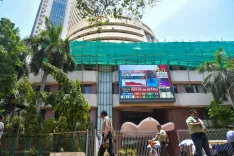Will Debt Recovery in Troubled Realty Projects Surge by 16% in 2025-26?

Synopsis
Key Takeaways
- The recovery rate for stressed real estate projects is expected to increase to 38%.
- Debt restructuring is vital for improving project viability.
- Robust demand in residential markets is driving sales growth.
- Two-thirds of rated projects are in the mid-premium segment.
- 40% of projects have restructured debt as a resolution strategy.
New Delhi, June 16 (NationPress) According to a recent report from Crisil Ratings, the overall recovery rate of Security Receipts (SRs) issued for distressed real estate projects is projected to rise by 16 percentage points, reaching 38 percent in the current financial year. This anticipated growth is attributed to a robust sales performance in new units within these projects, which is fueled by consistent demand in the residential real estate sector, supported by strategic debt restructuring efforts by the ARCs.
The Crisil report evaluates 70 distressed real estate projects located in regions like NCR, MMR, and micro-markets of Bengaluru, with SRs amounting to approximately Rs 10,800 crore.
Many of these projects have been ensnared in a continuous debt cycle due to dwindling sales, slow collections, and insufficient funds for construction—issues that are being resolved now.
Post-pandemic, an increase in real estate prices and heightened demand in these micro-markets has rejuvenated sales, making these projects appealing for external investment, the report notes.
It is anticipated that the demand for residential real estate in the aforementioned micro-markets will grow by 7-9 percent in 2025-2026, further bolstering sales for these distressed projects.
Approximately two-thirds of the evaluated projects are situated in the mid-premium segment and above, which are predicted to account for up to 80 percent of recoveries for ARCs, driven by stable demand in fiscal 2026. The remaining projects, classified as affordable, are expected to experience moderate demand and contribute less to recovery this fiscal year, according to the report.
The report identifies debt restructuring as the favored resolution approach for distressed real estate projects for two key reasons.
First, ARCs can reduce debt to manageable levels by offering an initial payment moratorium, which allows developers to channel project cash flow towards the construction of units.
Second, ARCs prefer restructuring due to fundamental issues within the real estate sector, such as dual ownership of land and development rights, multiple Special Purpose Vehicle arrangements with cross-collateralization, and various layers of approval necessary from state authorities.
While restructuring ensures that promoters retain a stake in the projects, allowing for quicker resolutions, the outlined issues render alternative methods like the Insolvency & Bankruptcy Code (IBC), enforcement, and liquidation more protracted, leading to lower recovery rates.
About 40 percent of the distressed real estate projects in the Crisil Ratings SR portfolio have undergone restructuring as the primary means of resolution, with expected nominal recoveries potentially amounting to the full principal amount of debt over an 8-year trust life, as stated in the report.









